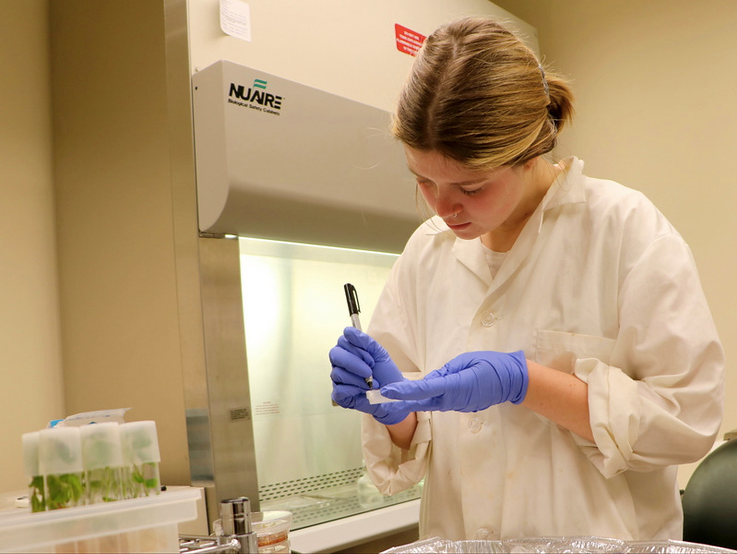In 2012, the World Bank estimated that 1.3 billion tons of solid waste are produced each year. Factors such as economic development, industrialization, social practices and location play into waste generation. Current projections estimate that human generated waste will only increase in the coming years, up to 2.2 billion tons annually by 2025. We are familiar with the three Rs: Reduce, Reuse, Recycle, their importance listed in chronological order. Yet current industrial practices hinder what sounds like a simple design. Reinventing conventional products as well as their production could drastically change the game, propelling us into a more sustainable future. Here are a few ways innovators are harnessing biology to develop unique solutions that decrease waste and increase sustainability in a variety of industries.
Mycelium is the vegetative part of fungi, made up of individual strands of hyphae. The mycelium possess powerful digestive enzymes that helps the fungi acquire nutrients. You’ve probably seen hyphae extending over that long forgotten jar of pasta sauce hiding at the back of your fridge. The cell walls of fungi are usually made of chitin, a resistant and durable polymer. Ecovative, a biomaterials company based in New York uses mycelium in order to replace conventional packaging such as Styrofoam. To harness this power, local agricultural waste can be inoculated with mycelium, and placed inside reusable frames. The mycelium, kept in its vegetative state, will grow to the shape of the frame. It will digest most of the natural by-product and build packaging that is fire resistant, fairly water resistant and decomposable. After approximately 5-7 days of growth, they are ready to be dried and shipped. When their purpose has been served, they can be broken up and will decompose outside in about a month, where residual nutrients can be absorbed into the soil.
Looking to the clothing industry, it is apparent that fast fashion has a deluge of harmful effects for people and the environment. Poor working conditions where employees are underpaid and subjected to health risks are paired with environmental destruction and high rates of pollution. Conventional dyes contribute to a large part of pollution generated by the fashion industry. They are synthetic, often petroleum based, and use a lot of water that needs to be heavily treated to be recycled – and often isn’t, being directly dumped into waterways. Natsai Audrey Chieza, a materials designer, aims to identify bacteria that could be used to as an alternative to conventional clothing dyes. Varying acidity results in the antibiotic Streptomyces coelicolor produces to elicit different pigment molecules. Currently, she is working with Ginko Bioworks, a biotech start-up that produces microorganisms for a variety of services. They are trying out various methods to expand the capacity of both fabric preparation and inoculation. Manipulation of fabric can impact how the bacteria will move, shaping the design of choice.
Biomaterials refer to entities developed to interact with the body for medical uses. They can be natural or man-made. Having the ability to biodegrade or be bio-absorbed is environmentally favourable, and can be less invasive to the individual. One such example are artificial retinas, the part of the eye that receives light, sending neural signals to the brain. Developing artificial retinas is difficult due to the sensitivity of the human eye. Vanessa Restrepo-Shild, a doctoral student at Oxford University has designed a novel retina formed from water droplets and biological cell membrane proteins. Single celled organism Halobacterium salinarum is used to make the bio-pixel that senses light. The soft, flexible, water based nature of the product increases the likelihood that the body will accept it. At this stage, the cells can detect light, produce electrical signals and create a grayscale image. Her team is continuing to work on its ability to perceive differences in colours and shapes.
Dr. Timothy Le and his team at MIT grow bacteria, such as Escheria coli into components of electrical circuits. This requires a combination of techniques in genetic engineering and protein chemistry. Bacterial cells are reprogrammed to assemble in a specific way, by regulating which genes are turned on and off. In this case, they can then respond to chemical signals to produce synthetic polymers. They could be programmed to clean up pollutant metals and amalgamate the bacteria into this growth of circuits. Ideally, they could become self-healing as well, if the product comes under duress. The processes involved in production would be less taxing on the environment, lowering the use of energy and harsh chemicals compared to conventional methods practices. His lab has also integrated mussel foot proteins with those of E.coli to develop underwater glue.
Our natural environment provides a myriad of potential ideas for improving our anthropogenic landscape. Some of the aforementioned examples use unaltered organisms, but many of these researchers are open to exploring the possibilities of synthetic biology. This relatively new field is a synergy between engineering principles and biology that interweaves living cells with beneficial aspects of non-living material. Whatever pathway is chosen to the development and improvement of industry; it should be one that is answerable to its practices. Sustainable innovation must be comprehensive of its actions, and have the flexibility to improve as new visionaries step up to shape it.
Sources:
https://www.ted.com/talks/eben_bayer_are_mushrooms_the_new_plastic
https://www.ted.com/talks/natsai_audrey_chieza_fashion_has_a_pollution_problem_can_biology_fix_it
https://www.nature.com/articles/srep46585
https://www.nibib.nih.gov/science-education/science-topics/biomaterials
http://www.bbc.com/news/science-environment-26691016




